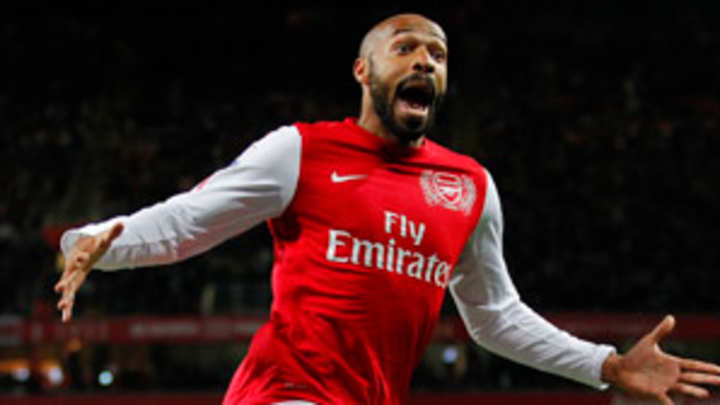Henry's return to Arsenal -- and goal -- represents best in sports


One mosquito-addled evening in the Arctic Circle, I met a Laplander in an Arsenal shirt who -- on seeing the Arsenal sticker on my suitcase -- told me that he'd once bought golf clubs in London from a man who'd sold golf clubs to Dennis Bergkamp.
There was something in the man's monotone that suggested he hadn't seen the Arsenal sticker on my suitcase after all, but rather said the same thing to everyone he encountered in that lonely outpost on the top of the world: "I bought my golf clubs in London from a man who sold golf clubs to Dennis Bergkamp."
Anyone who saw Bergkamp play for Arsenal would understand the devotion of this Finnish fan, and anyone who didn't see the Dutchman need only check YouTube to understand why we'd all be thrilled to own golf clubs bearing the secondhand celebrity of Dennis Bergkamp.
Today, Arsenal has another Dutch striker in a number 10 shirt, Robin van Persie, son of two artists and heir to the family vocation, though his artistry, like Christy Brown's, is expressed with his left foot. He is delicate as Delft pottery, but at the moment van Persie is still in one piece and at the apex of his powers, having scored 50 goals in all competitions in 2011, 35 of them in the Premier League alone.
It's a measure of our shrunken world that I found myself -- 15 years after that Laplander robotically told me of his brush with Bergkamp -- on another mosquito-addled evening, in another isolated outpost, passing a young stranger who wore an Arsenal shirt with V. PERSIE on the back of it.
There were only two adults on this bike path in the remote New England town where I live, and both were Arsenal fans, and that is surely a tribute to the man who bridged Bergkamp and van Persie. Thierry Henry became a household name on my American street, at least in the house next door (a Man United fan who nevertheless owns a No. 14 Arsenal jersey); in the house across the street (a Barca fan from Liberia); and in the house next to that (a college kid who supports Chelsea but appreciates quality).
On my street, the Frenchman achieved what Bergkamp had not: Market penetration. Henry appeared in Gillette commercials with Tiger Woods and Roger Federer, sat courtside at the NBA Finals to watch his friend Tony Parker and the Spurs, wore his socks above his knees like a Catholic schoolgirl and generally carried himself with élan, elegance, panache and a lot of other French words while leading Arsenal's 2003-04 "Invincibles" to top-flight English soccer's first unbeaten season since 1889.
In one match in 2004, at the edge of the six-yard box, with his back to the goal and a Charlton defender literally mounting him for a piggyback ride, Henry scored without bothering to turn around. He could send rockets in under the crossbar, but also beat the keeper with the kind of chip shots and flop shots more familiar to Phil Mickelson, as if he'd bought his feet from a guy who sold golf clubs to Dennis Bergkamp.
Unlike David Beckham, Henry was best known here for his soccer, not his celebrity. As the finest player in the world's most popular league, he was runner-up two years running -- first to Zidane, then to Ronaldinho -- in FIFA World Player of the Year voting. Like Beckham, he inevitably left England for Spain, and now plies his trade in the late afternoon of his career in the United States, for the New York Red Bulls. In the MLS offseason, he trains in London with his old team, who recently dedicated a bronze statue of him outside the Emirates Stadium.
There, Henry is forever on his knees celebrating a 2002 goal for Arsenal against archrival Tottenham, having dribbled 70 yards before scoring on their American keeper, Kasey Keller, then running another 70 yards to knee-slide into eternity.
And there he was expected to remain, forever frozen in celebration, until manager Arsene Wenger signed the 34-year-old on a six-week loan, in a season of no great promise for Arsenal, a club that has endured a lot of other French words since Henry's departure, principally malaise and ennui. The loan news last week inspired some ambivalence and trepidation, but mostly a benign nostalgia among Arsenal fans. "What's the worst that could happen?" thought many. But also: "What's the best?"
Watching sports can be like jury duty: Most of the time it's routine, dull even. But every once in a while, if you show up every day at the television set, you will be present for something sensational.
And so on Monday night, in his first game back, Henry sat on the bench for the first 67 minutes at the Emirates and still led the fans' Man-of-the-Match voting. That was enough, really. When he came on as a substitute midway through the second half of a scoreless draw against Leeds in the third round of the FA Cup, to a standing ovation, the evening was complete. Henry looked -- with shaved head and full beard -- thicker, older and less feline than his former self, though still more feline than you or I ever have.
But then there was only that brief glimpse of him in repose, because 10 minutes into his return Henry slipped behind the Leeds defense, took a pass at a dubious angle to the left of the goal and curled the ball past the keeper and just inside the far post for the game-winner. As the stands shook, Henry sprinted around like a man in flames, thumped the Arsenal badge on his chest and bear-hugged Wenger while looking like an actual bear. Outside the stadium, his statue sprung goose bumps.
The beauty of sports and life is that this kind of thing never happens. And then it does. "It was a little bit of a dream, because it was a story about football you would tell some young children," Wenger said. "Unfortunately it is not often like that in our game."
For his part, Henry said that his latest goal for Arsenal was different from the 226 that went before: It was the first he'd scored as a supporter of the Gunners. In his absence from the club, Henry became a familiar spectator in the stadium, in a red-and-white scarf, like the ones that now get draped around his statue's neck, presumably to keep it warm until a new beard can be sculpted on.
In other words, Henry has done for himself what he inspired thousands to do in the years between that Laplandic lover of Early Bergkamp and that New England devotee of Present-Day van Persie: He became, like so many others, a fan.
